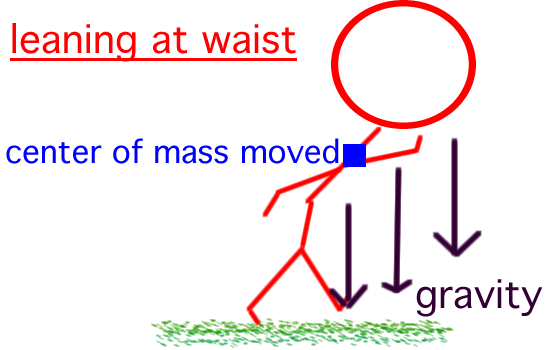
Working with the Center of Mass
The center of mass for an object is the point within the system describing the average position of its mass. The center of gravity is an equivalent effect at a point of all the small elements of the body acted upon the gravitational force. For the human body, the center of mass is at the same position as with the center of gravity. This is because force of gravity is proportional to the mass of the body and is uniform over the entire person. So it is accepted, when discussing biomechanics, to interchange center of mass and center of gravity for the same definition. When running the center of mass is located in front of the spine below the navel because this point lies on the axis of symmetry for the human body.

Two ways to use this knowledge for effective running and for the sake of exercising physics, is to run with a lean and to lift the knees to mimic a circular motion.
Leaning
When running upright, gravity pulls straight down on the body. This does not help the forward linear motion the runner is trying to achieve.

However, running with a lean allows gravity to pull the runner forward. As the runner leans, the center of mass moves in front of the point of contact with the running path. This causes gravity to pull down on the runner in more of a horizontal forward direction and less of a vertical pull. In other words, efficient running uses less physical energy because the tilting of the body acts as a controlled “fall.” This lean should be in alignment from the ankles all the way up the spinal cord to the top the runner’s head. This lean can come easier to a runner if thought of as leading the forward motion with the forehead. Aligning the runner’s form this way keeps the center of gravity of the runner in the same position as when standing.

If the column of the runner is not aligned then the center of mass changes and causes running to be inefficient.

A leaning column also acts as a way to control a runner’s speed. The further the runner leans, the faster the runner’s body will allow to move forward. This is because the distance between the center of mass and Earth has decreased which increases the force of gravity. As stated before, the magnitude of the force of gravity is:
Fg = GMm / d
Mathematically this statement holds because a smaller denominator (distance) yields a larger number.
Conversely, leaning less reduces the speed of the runner. This is useful for efficient running because instead of using muscle power to run faster, leaning the column works equally as well and leads to less leg muscle injury.

Landing mid-foot beneath the center of mass is important because this allows gravity to pull down on a runner’s foot and leg naturally, allowing the runner to relax the calf muscles and ankle joints.

If landing in front of the center of mass, this causes that leg in contact with the running path to act as a force opposing the forward linear motion. In other words, landing this way slows down the runner’s speed and makes the force of the body work harder to oppose the force of that leg in front. Obviously, landing behind the center of mass is awkward for the runner because it puts the body out of balance. Therefore, landing directly (or close to) under the center of mass is the most effective for running.
Lifting Knees into Circular Motion
Swinging legs to run and using them as pendulums is inefficient because this method causes muscles to tense up which leads to injury. Instead of treating legs as pendulums, runners can lift their knees in a circular motion to run. Lifting the knees causes the runner to naturally land mid-foot beneath the center of gravity. This method is efficient for running because it allows the runner’s body to keep up with the controlled “fall” due to leaning. Lifting the knees also reduces the hard impact felt by knees because the upward raise of one knee counterbalances the falling motion of the other knee. In this way, the quad muscles in the thighs are doing most of the work to run, allowing the calf muscles and ankle joints to relax.
Although it is a fictional cartoon character, the Roadrunner exhibits excellent lean and circular lifting of the knees. Maybe all of the efficient running due to physics is the reason why the Coyote can’t ever catch up to him!

http://www.yatego.com/comic4you/p,417233d36edf4,4152d0ca962a63_0,looney-tunes---road-runner-running---polyesterfigur
Home | Forces | Pendulums | Center of Mass | Pelvic Rotation | Extras | Bibliography